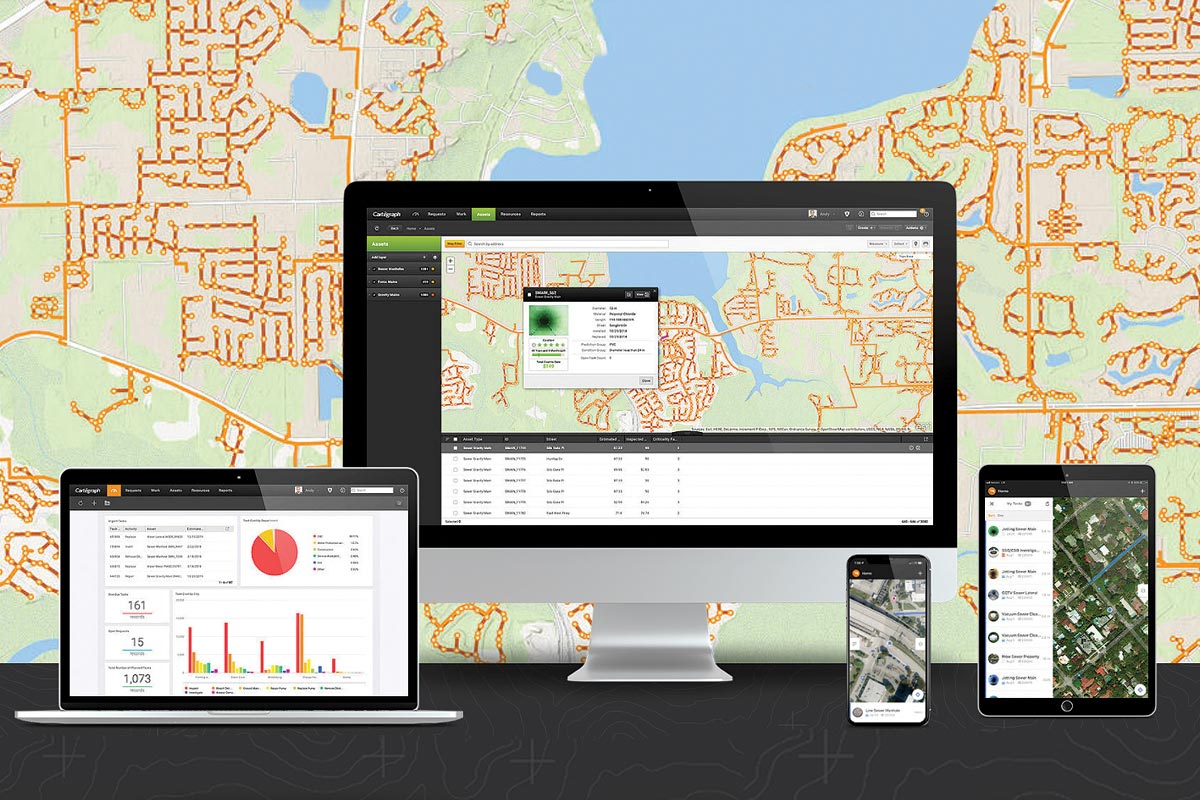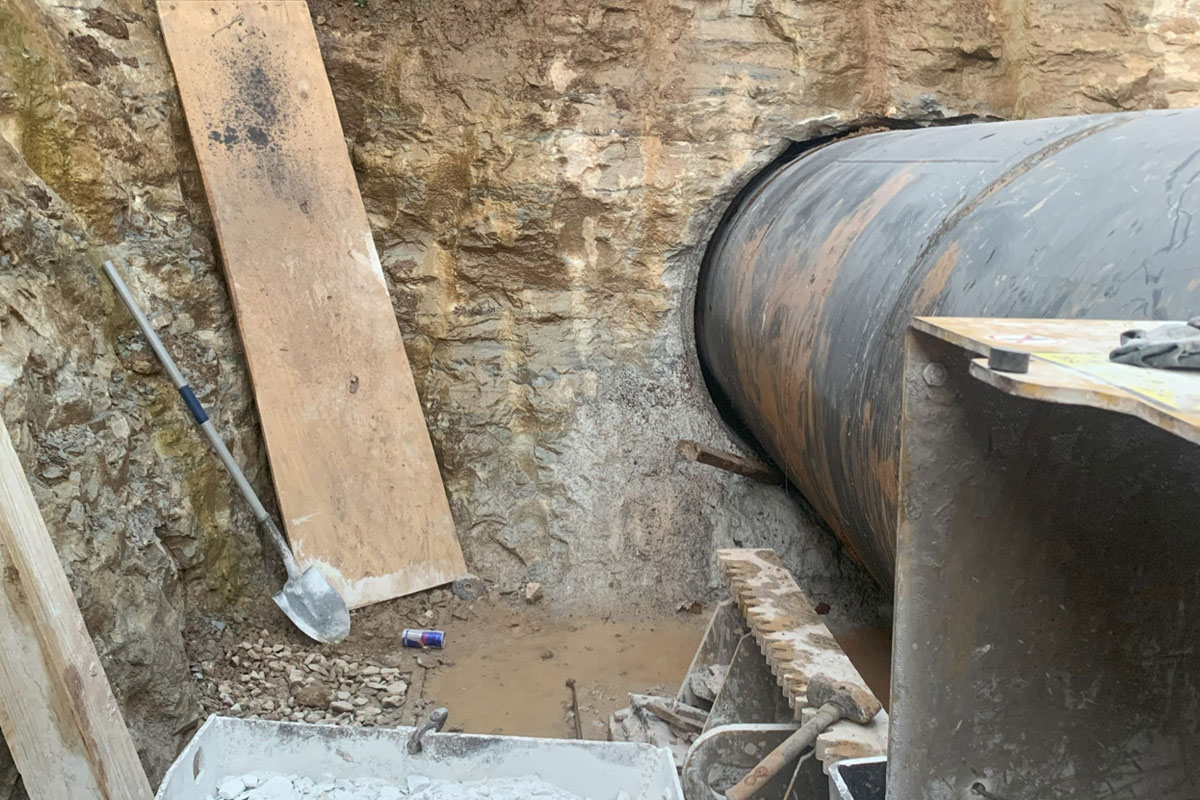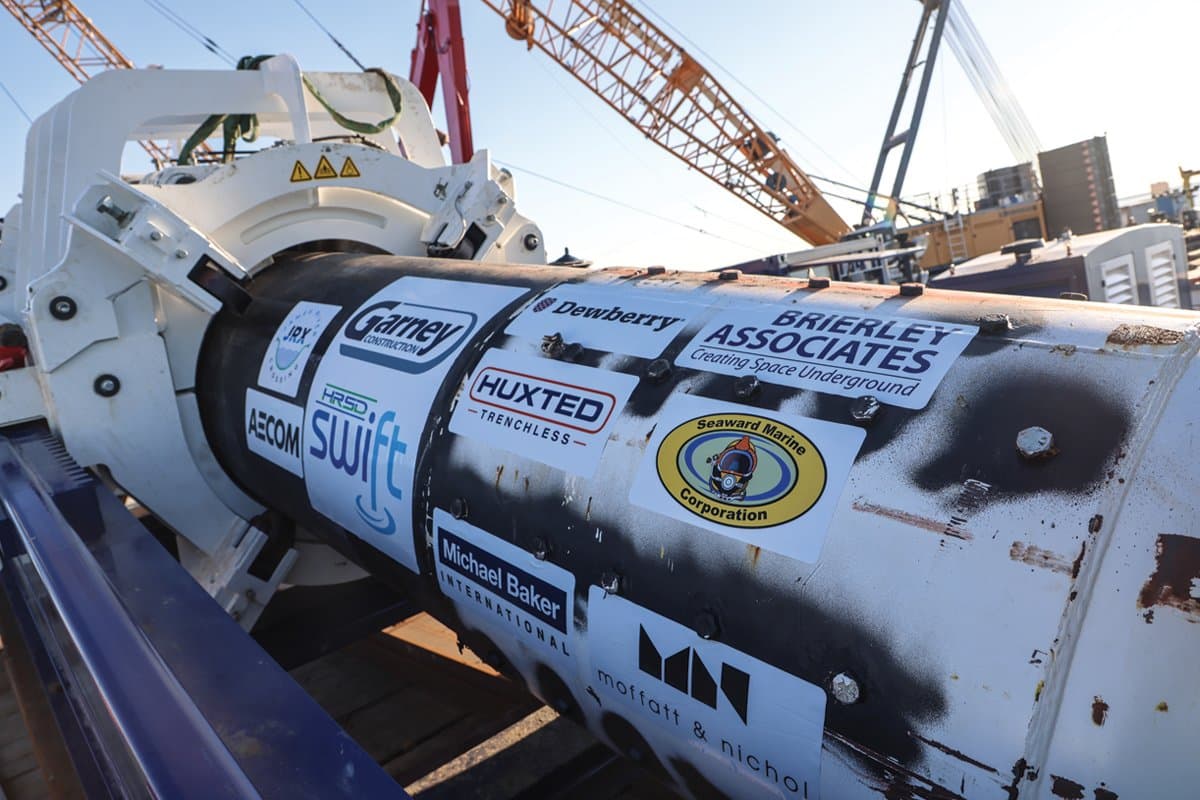
No-Dig North 2022 Canadian Project of the Year New Installation
York Durham Sewage System Forcemain Twinning Project
As part of its Water and Wastewater Master Plan the York region identified its York Durham Sewage System (YDSS) as needing an upgrade.
The York Durham Sewage System, originally built in the 1980s as a single forcemain by the Province of Ontario, was transferred to York Region in the 1990s. The Town of Newmarket’s local sewers connect to the YDSS and the forcemain conveys effluent to the Duffin Creek treatment plant.
With the project on the roster of scheduled capital improvements, the York Region worked with its design consultant GHD Ltd. to design the YDSS Forcemain Twinning project to maximize the Region’s dollars and minimize disruption to the community and natural environment
“Planning for new sewage infrastructure that must run all underground through highly congested urban areas can be daunting. For the York Region’s forcemain twinning project in the Town of Newmarket, conceived to improve the system’s reliability and to ease maintenance, GHD Ltd. was selected to undertake the vast engineering scope required for the new pipeline,” says Bradley Marin, C.E.T., C.T., senior technical director at GHD. “The design would need to not only consider safety, constructability, and durability, but also to honour the community’s core values: concern for the environment and aversion to disrupting utilities, traffic or just plain peace and quiet.”
This was a daunting project from Day I and close collaboration between all parties involved was a key to its overall success. This is especially true considering that seven months into the project the world would be rocked by the COVID-19 pandemic. Despite the challenge of the pandemic, many lessons were learned that will help advance the microtunnelling industry across North America.
The YDSS Forcemain Twinning Project was recently selected as the No-Dig North 2022 Canadian Project of the Year Award New Installation.

Going Trenchless
Through intense consultation with industry experts, GHD quickly determined that a mostly trenchless approach would be most beneficial. More specifically, the microtunnelling of a two-pass system for the approximately 5.2 km long project.
“GHD initiated an expert panel workshop of industry leaders, did exhaustive investigations, and considered all feasible solutions. We then settled on an unprecedented solution: completing a microtunneling project with not just one, but two of the longest curved reaches ever achieved in North America,” says Marin. “Eschewing industry skepticism, we designed the project to include just nine shafts — located carefully so the sites would cause minimal disruptions to the environment and traffic — from which to advance the tunnel sections. We created an animated video to engage the public and explain the process, emphasizing controls for erosion, light, noise and unpleasant views.”
According to the project’s website, the overall project involves:
- Building a new twinned forcemain to move wastewater from the Newmarket Pumping Station to the Aurora Pumping Station.
- Building a new twinned forcemain to move wastewater from the Bogart Creek Pumping Station to the YDSS forcemain.
- Modifications to the Newmarket and Bogart Creek pumping stations.
During project constructability assessment process, GHD planned the geotechnical investigations to assess the ground conditions. The design team also completed geotechnical, hydrogeological, topographical, environmental, archaeological investigations and environmental studies. The team also completed ecological surveys, hydraulics modelling, settlement analysis, noise impact assessment, risk management and compensation plantings.
“One of the reasons why GHD selected microtunnelling was to address our concerns. And when we looked at the location of the construction sites, all were chosen with the thought of minimized disruption,” says Susan Hansler, P.Eng., PMP, project manager, capital planning and delivery, Public Works Department at York Region. “When we did get into construction, Ward & Burke offered further ways to minimize this disruption by eliminating three construction areas by lengthening the drives.”
With a design in place that called for a mix of 51045 m of microtunnelling and 480 m of open-cut work, the project went to tender. Winning the project was Ontario-based Ward & Burke Microtunnelling Ltd.
To help defray some of the cost of the $102.5 million project was Infrastructure Canada recognizing the YDSS Forcemain Twinning project for providing resilient critical infrastructure. It committed to funding up to $48 million under the Disaster Mitigation Adaptation Fund for construction.
Modifying the Plan
“When we looked at the project from a microtunnelling aspect, the main forcemain alignment already had some fairly long tunnelling drives, but there were two shafts along the original design alignment that were located in difficult to build locations,” says John Grennan, director, Ward & Burke. “Our opinion was that those two shaft locations brought unneeded risk to the project. We proposed to eliminate the two locations by extending the microtunnel drive lengths. By eliminating those two shafts, we ended up having…I suppose…two record-setting distance drives, in terms of length, in Canada. One was 950 m long and the other being 1,132 m long.”
Eliminating two shafts to bring down the risk of a project is a bold move considering the risks involved with long drive lengths, however, Ward & Burke backed up the suggestion offering data from similar projects it completed in Europe.
“Their longest drive length, before we offered any design changes, was 832 m. That was longer than others designed in Canada, or the U.S. for that matter, at that time,” says Grennan. “Because of our experience, our systems and our capabilities, it was our role to prove that we would be able to go that distance. We showed where we would install intermediate jacking stations, how we would manage the jacking loads, how we would lubricate the tunnel and how we would power the tunnel boring machine. We were able to prove to them that going longer was a low-risk consideration.”
Grennan, a longtime tunneller, went on to note that in the European marketplace, where Ward & Burke cut its teeth, a 1,200-m drive was achieved two decades ago. Because the market here is not as mature, these longer lengths are quickly being worked towards. And each successfully completed project boosts owner and engineer confidence alike.
“That section of forcemain was not as deep, and I think there was some idea that open-cut would be a lower cost option rather than microtunnelling,” Grennan says. “We worked with the engineer and the owner to optimize that alignment and offer microtunnelling at the same cost that they planned for open-cut.”
All told, Ward and Burke was responsible for seven microtunnel drives, totaling approximately 5,576 m in length. The microtunnelling drives – in order of completion – were 818, 731, 501, 641, 821, 950 and 1,132 m.
RELATED: Trenchless Insights: A Q&A with GHD’s Bradley Marin
Construction on the project commenced in June 2019 with Ward & Burke serving as the general contractor for the project, self-performing most of the work including shaft construction, microtunnelling, installation of the forcemain, concrete cambers, mechanical pipework and valve installation and all tie-ins to existing infrastructure. GHD continued by maintaining an engineering overview on the project on behalf of the Region. GHD also handled construction administration and tunnelling inspection services.
Microtunnelling Setup
For the microtunnelling, Ward and Burke used three remanufactured Herrenknecht AVN slurry machines – two AVN1800s for the main forcemain and an AVN1200 for the smaller Bogart forcemain. All were outfitted with mixed-ground cutter heads to properly deal with the varied ground conditions. Navigation was via VMT SLS LT guidance systems. Lubrication is key on microtunnelling projects and Ward & Burke used Baroid Bore-Gel and Diff Speed Engineering slurry separation systems. The reinforced concrete microtunnelling pipe was sourced from Ontario-based DECAST Ltd. The pipe is an ASTM C76 Class V, with ASTM C361 joints.
Centerline tunnel depths varied from 5.5 m to 22 m below ground and the grades throughout were between 1.56 per cent on the initial segment to negative 0.61 per cent on the fourth drive. All the sections involved straight segments and curved portions, with the sharpest radius at 435 m. In the record-breaking longest drive, the AVN1800 navigated a horizontal curve of 500 m radius over 228 m and a flat continuous grade of 0.02 per cent.
Aside from the length of the two longest runs, the major challenges Ward & Burke faced when tunnelling involved the mixed ground conditions and high-water tables that were, on average, 12 m above the tunnel centerline. The latter prompted GHD to require Ward & Burke to outfit its AVN1800 machines with airlocks to mitigate the risk associated with a ceased drive.
“The ground conditions would change regularly from the soft clay, into sands and gravels and then to hard glacial till with boulders and then back to soft ground. That could all happen on a single drive,” says Grennan. “With long drive lengths and high-water pressures of 1.4 bar on average, the engineering design team felt that an airlock would be advisable in case wear on the cutterhead became an issue. Without one we would not have been able to carry out a face refurbishment.”
Common on larger diameter tunnels, the use of an airlock was a first for Ward & Burke on a North American microtunnelling project, and according to Grennan’s knowledge was the first microtunnelling in Canada to require its use. The airlock was purchased from Herrenknecht, and Ward & Burke worked with ASI Marine to adapt it for use on the MTBM. The system also required Ministry of Labour approval before use.
“We did tests and trials on the system for a possible intervention. However, ultimately it was not needed on the project. The experience gained will be valuable for future jobs,” Grennan notes.
Despite changing ground conditions and a high-water table, the microtunnelling was fairly low-key, which Grennan attributes to proper planning, having a robust machine mated to the right cutter heads and using a high-quality bentonite for lubrication. All of this was also important when the crews were thrown a curveball in March 2020…the COVID-19 pandemic.

Pandemic Shutdown
“At the peak of the first wave at the end of March, a stay-at-home order was placed in Ontario. Our job was considered as essential construction, permitting us to work through the stay-at-home order,” Grennan says.
However, based on the widespread panic in society, including limited data about the virus and lack of available PPE, Ward & Burke opted to shutdown construction and assess the situation and come back with a well thought out health and safety plan in place.
“The health and safety of our workers were most important to us. It was at a time when we couldn’t get masks, sanitizer and the workers were distracted, as well,” Grennan says. “When you are building a record distance tunnel, you can’t be distracted by anything else. You have to be focused on the job you are doing.”
At the time of the shutdown, both AVN1800 machines – which were used simultaneously throughout the project – were each 200 m into the 950-m and 1,132-m record-length drives. Based on historical data from other projects, Ward & Burke knew that with a properly lubricated tunnel, they could stop the work and pick up again after they regrouped and do so at the same jacking forces.
“We were building these drives simultaneously and they were our last two tunnels on the project. There were some concerns from the owner and engineer that we might not be able to move the microtunnel again after a four-week shutdown,” Grennan says. “As it turned out, our predictions were correct, and we recommenced microtunnelling at the same jacking force and finished both record drives without the use of any intermediate jacking station.”
Successful Completion
As this is a two-pass project – with Ward and Burke handling all aspects of construction – as microtunnelling work completed, Ward & Burke crews installed DECAST’s concrete pressure pipe for the final forcemain installation.
“Thorough and careful workforce planning allowed Ward & Burke to execute production tunnelling drives in an efficient way throughout the project,” says Mike Rabeau, director, Capital Planning and Delivery for Public Works at York Region. “Prudent prioritization of shop drawing submittals allowed for suppliers and vendors to start orders early; in-house engineering, design and manufacturing by Ward & Burke allowed full control of the supply chain for key components necessary to construct shafts and install the forcemain, which proved invaluable to achieving schedule.”
The YDSS forcemain was commissioned by the Region in May 2021 and the project achieved substantial completion in September 2021 ahead of the original schedule. A year later and Rabeau is pleased to report that the areas disturbed by construction activities have been restored and – in many cases – are better than before the project.
“The York Region’s values toward strong, caring and safe communities meant addressing concerns by the Lake Simcoe Region Conservation Authority, Town of Newmarket, residents, business owners and community groups alike. The project team listened to community feedback and incorporated suggestions into construction site restoration,” he says. “All work site locations have been restored; the Queen Street site, adjacent to Tom Taylor Trail, received enhanced restoration due to its proximity to the heavily used trail and impact to surrounding residences. Restoration included a garden, seating area around the sealed shaft site, bike repair station and additional native trees and shrubbery were planted.”
Project Details
Project Owner: Regional Municipality of York
Engineer: GHD Ltd
Contractor: Ward & Burke Microtunnelling Ltd.
Value of Trenchless Project: $104.9 million
Editor’s Note: This story originally appeared in the Summer 2021 issue of Trenchless Technology Canada. It appears here with some new information provided by York Region and GHD Ltd.
Mike Kezdi is the managing editor of Trenchless Technology Canada.




